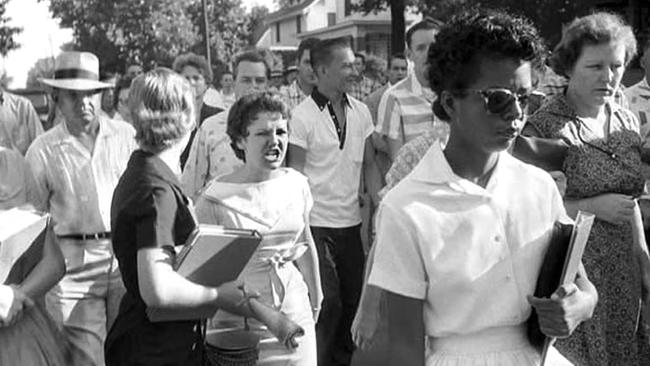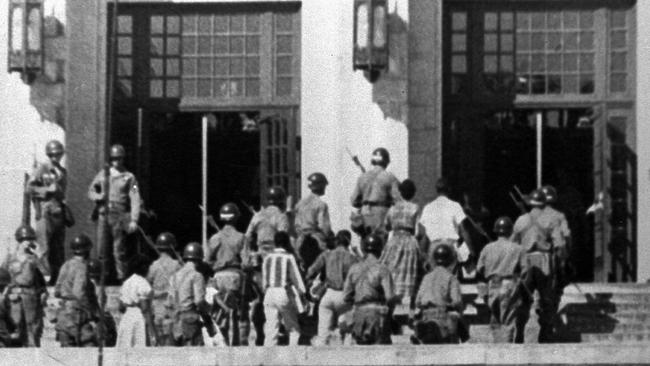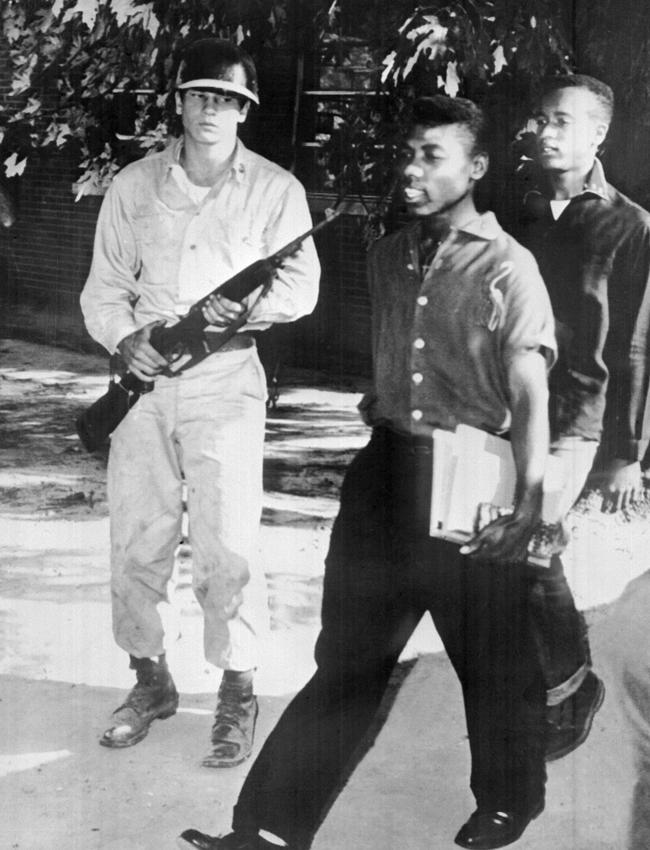‘Little Rock Nine’ black students were each worth $10,000 dead in civil rights protest
AT least 2500 people stood by as nine black teenagers climbed stairs at the grand entrance to Arkansas’ Little Rock Central High School on a mild, sunny Wednesday morning 60 years ago.

Today in History
Don't miss out on the headlines from Today in History. Followed categories will be added to My News.
AT least 2500 people stood by as nine black teenagers climbed the stairs at the grand entrance to Arkansas’ Little Rock Central High School on a mild, sunny Wednesday morning 60 years ago.
Half were army paratroopers sent to protect the students from 1500 protesters, among them members of the White Citizens’ Councils who had offered $10,000 for each of them dead, or $5000 alive.
After another day of extremist protests in Little Rock, in a media address the night before US President Dwight Eisenhower explained an Executive Order to use “troops under Federal authority to aid in execution of Federal law at Little Rock”.
Troops in full battledress with fixed bayonets and rifles arrived in Little Rock that night to take over from local police after three weeks of disturbances.
“The very basis of our individual rights and freedoms rests upon the certainty that the President and the Executive Branch of Government will support and insure the carrying out of the decisions of the Federal Courts, even, when necessary with all the means at the President’s command,” Eisenhower said. “Unless the President did so, anarchy would result. Mob rule cannot be allowed to override the decisions of our courts.”

School segregation was outlawed by the 1954 US Supreme Court decision in Brown v. Board of Education of Topeka, Kansas, which declared all laws establishing segregated schools were unconstitutional, and called for the desegregation of all US schools.
Considered one of the more progressive southern US states, the University of Arkansas School of Law had been racially integrated since 1949, and Little Rock Public Library since 1951. The Little Rock School Board in 1955 agreed to racially integrate high schools in 1957. But the National Association for the Advancement of Colored People (NAACP) took legal action, arguing the plan was too gradual. A federal judge dismissed the suit, saying the school board was acting in “utmost good faith”.
By early 1957, 517 black students lived in the Little Rock Central High district, and 80 expressed an interest in attending Central. After interviews by the Little Rock School Board, 17 students were selected on academic performance and attendance, but eight decided to remain at all-black Horace Mann High.
The “Little Rock Nine”, Ernest Green, Jefferson Thomas, Terrence Roberts, Elizabeth Eckford, Carlotta Walls LaNier, Gloria Ray Karlmark, Thelma Mothershed, Minnijean Brown and Melba Pattillo Beals, all aged 15 or 16, tried to enter the school on September 2, 1957.
But Arkansas governor Orval Faubus, a staunch segregationist, called the Arkansas National Guard to surround Central High to prevent integration, ostensibly because he feared bloodshed. Next day Federal District Judge Ronald Davies ordered integrated classes to begin on September 4. Faubus then deployed the Arkansas National Guard to support segregationists: When the black students tried to enter, guardsmen said the school was “out of bounds” to them.

The line of soldiers blocking the students made national headlines. Traumatised by the events, Eckford, recalled “They moved closer and closer. ... Somebody started yelling. ... I tried to see a friendly face in the crowd — someone who maybe could help. I looked into the face of an old woman and it seemed a kind face, but when I looked at her again, she spat on me.”
Little Rock School District issued a statement to condemn the governor’s action, and Eisenhower summoned Faubus for a meeting, warning him not to defy the Supreme Court’s ruling.
The nine remained at home for two weeks, and Little Rock mayor Woodrow Wilson Mann asked Eisenhower to send federal troops to protect the nine students. When they tried to re-enter the school again on September 23, an angry crowd outside beat African-American reporters who were covering the events.
Although students were warned by a commanding officer that anyone who disrupted the school day would be handed to local police, Pattillo later had acid thrown into her eyes and burning paper dropped on her while trapped in a toilet cubicle. White students who helped black students were also intimidated. Learning there was a price on her head, Brown’s family sent her to a foster family in California.
“We were physically assaulted every day,” Eckford recalled. “The principal’s rule was that he wouldn’t act on any reports if a teacher didn’t corroborate what we said happened. It was a co-ordinated group of about 55 students who attacked us, out of 1900 students at the school.”
In September 1958 Faubus, defeated by Bill Clinton in 1986, blocked desegregation by closing Little Rock’s four high schools, leaving 3665 students without classes and putting 177 teachers and staff out of work.


